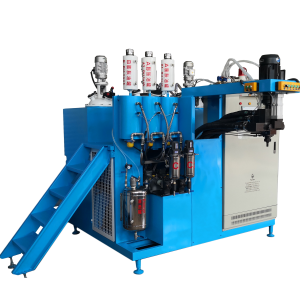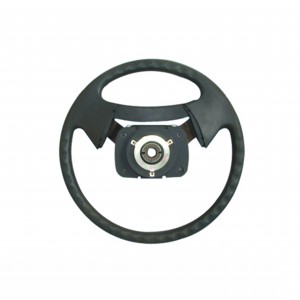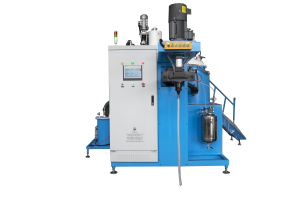Mixing head of polyurethane elastomer equipment: stirring mixing, mixing evenly. Using a new type of injection valve, the vacuum degree is good to ensure that the product has no macroscopic bubbles. Color paste can be added. The mixing head has a single controller for easy operation. Component storage and temperature control: Jacket style tank with visual level gauge. Digital pressure gauges are used for pressure control and feature/minimum alarm values. Resistive heaters are used for component temperature regulation. The tank is equipped with a stirrer to mix the material evenly.
Equipment application of polyurethane elastomer equipment production:
1. Semi-rigid self-skin foaming: used in various furniture accessories, board chair armrests, passenger car seat armrests, massage bathtub pillows, bathtub armrests, bathtub backrests, bathtub seat cushions, car steering wheels, car cushions, car interior and exterior Accessories, bumper bars, medical and surgical equipment mattresses, headrests, fitness equipment seat cushions, fitness equipment accessories, PU solid tires and other series;
2. Soft and slow-rebound foam: all kinds of slow-rebound toys, slow-rebound artificial food, slow-rebound mattresses, slow-rebound pillows, slow-rebound aviation pillows, slow-rebound children’s pillows and other products;
3. Soft high-resilience foam: toys and gifts, PU balls, PU high-resilience furniture cushions, PU high-resilience motorcycle, bicycle, and car seat cushions, PU high-resilience fitness sports equipment saddles, PU dental chair backrests , PU medical headrest, PU medical bed forming mattress, PU high resilience boxing glove liner.
4. Soft and hard garden categories: PU flower pot ring series, environmentally friendly wood bran flower pot series, PU simulation flower and leaf series, PU simulation tree trunk series, etc.;
5. Rigid filling: solar energy, water heaters, prefabricated direct-buried heating and thermal insulation pipes, cold storage panels, cutting panels, steamed rice carts, sandwich panels, rolling shutter doors, refrigerator interlayers, freezer interlayers, rigid foam doors and windows, garage doors, fresh-keeping boxes, Insulation barrel series;
6. Soft and hard environmental protection buffer packaging: used in various fragile and valuable packaging products and other series;
7. Hard imitation wood foam: hard foam door leaf, architectural decoration corner line, top line, ceiling plate, mirror frame, candlestick, wall shelf, speaker, hard foam bathroom accessories.

The raw materials for polyurethane elastomers are mainly three categories, namely oligomer polyols, polyisocyanates and chain extenders (crosslinking agents). In addition, sometimes in order to increase the reaction speed, improve the processing performance and product performance, it is necessary to add some compounding agents. Only the raw materials used in the production of polyurethane saddles are described in detail below.
Polyurethane elastomer products are colorful, and their beautiful appearance depends on colorants. There are two kinds of colorants, organic dyes and inorganic pigments. Most of organic dyes are used in thermoplastic polyurethane products, decorative and beautifying injection parts and extruded parts. There are generally two ways for coloring of elastomer products: one is to grind auxiliary agents such as pigments and oligomer polyols to form color paste mother liquor, and then stir and mix an appropriate amount of color paste mother liquor and oligomer polyols evenly, and then heat them. After vacuum dehydration, it reacts with isocyanate components to produce products, such as thermoplastic polyurethane color granules and color paving materials; another method is to grind additives such as pigments and oligomer polyols or plasticizers into color paste or color paste , dehydrated by heating and vacuum, and packaged for later use. When using, add a little color paste into the prepolymer, stir evenly, and then react with the chain-extending cross-linking agent to cast the product. This method is mainly used in MOCA vulcanization system, the pigment content in the color paste is about 10% -30%, and the addition amount of the color paste in the product is generally below 0.1%.
The polymer diol and diisocyanate are made into prepolymers, which are fully mixed together, injected into the mold after vacuum defoaming, injected into the mold and cured, and then cured to obtain the product:
First, dehydrate the polyurethane elastomer equipment under reduced pressure at 130℃, add the dehydrated polyester raw material (at 60℃) into the reaction vessel containing the compounded TDI-100, and synthesize the prepolymer with sufficient stirring. The synthesis reaction is exothermic, and it should be noted that the reaction temperature should be controlled within the range of 75℃ to 82℃, and the reaction can be performed for 2 hours. The synthesized prepolymer was then placed in a vacuum drying oven at 75°C, and degassed under vacuum for 2 hours before use.
Then heat the prepolymer to 100℃, and vacuumize (vacuum degree -0.095mpa) to remove air bubbles, weigh the cross-linking agent MOCA, heat it with an electric furnace at 115℃ to melt, and coat the mold with a suitable release agent to preheat (100℃). ), the degassed prepolymer is mixed with the melted MOCA, the mixing temperature is 100℃, and the mixture is stirred evenly. In the preheated mold, when the mixture does not flow or stick to the hand (gel-like), close the mold and place it in a vulcanizer for molding vulcanization (vulcanization conditions: vulcanization temperature 120-130 ℃, vulcanization time, for large and Thick elastomers, the vulcanization time is more than 60min, for small and thin elastomers, the vulcanization time is 20min), post-vulcanization treatment, put the molded and vulcanized products at 90-95 ℃ (in special cases, it can be 100 ℃) Continue to vulcanize for 10 hours in the oven, and then place it at room temperature for 7-10 days to complete the aging and make the finished product.
Post time: Sep-27-2022




